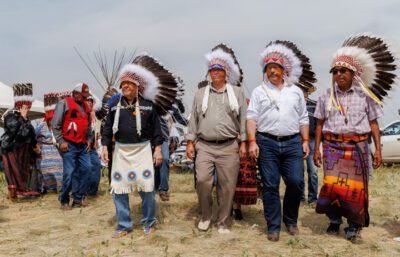Honourary chiefs inducted
By Lethbridge Herald on July 31, 2024.
 Photo courtesy of David Rossiter
Max Gibb, Glenn Miller and Jason Kenney are seen during the honour dance with Chief Roy Fox after they were named honourary chiefs on the Blood Reserve on Monday.
Photo courtesy of David Rossiter
Max Gibb, Glenn Miller and Jason Kenney are seen during the honour dance with Chief Roy Fox after they were named honourary chiefs on the Blood Reserve on Monday.Alexandra Noad
Local Journalism Initiative reporter
Four new honourary chiefs were inducted Monday on the Blood Tribe Reserve.
The inductees include former Premier Jason Kenney, Christine Roberson, president of Indigena Holdings, Glenn Miller, president of the Last Post Fund and Max Gibb, Chief Executive Officer and principal of the Rocky Mountain Turf Club.
People are selected as honourary members of the Kainai Chieftainship through their contributions of advocacy for the Blood Tribe.
There is a maximum of 40 living honourary chiefs for the Kainai Nation and there are currently 33 honourary chiefs today.
Miller says it was a humbling experience for everyone involved.
“All of the inductees were quite humbled, including myself, and honoured to be asked and we accepted the the honourary chieftainship,” said Miller.
Miller says he was introduced to the Blood Tribe when he offered the late senator Joyce Fairbairn a ride to a chieftainship meeting and while waiting he met people who were attending a powwow.
He then became immersed in the culture and “hasn’t looked back since.”
Gibb says he met members of the Blood Tribe while boxing and horse racing.
The Rocky Mountain Turf Club hosts the Warrior Relay Races every year, with horses being considered a sacred animal to the Blackfoot people.
“We call them warrior relay races at the track and they also run horses at the track. The horse is a healer for many people and very much a spirit animal for our First Nations, our Indigenous friends,” said Gibb.
According to the book Tribal Honors – A History of the Kainai Chieftainship by Hugh A. Dempsey published in 1997, “the Kainai Chieftainship is one of the most prestigious organizations in North America.”
The book adds the Kainai Chieftainship was launched in 1919 and formally established in 1950.
The role of an honourary chief is to help promote cultural pride of Blackfoot and Kainai Nations as well as be a resource to the First Nations.
The ceremony consist of the honourary chiefs meeting in a tipi with the chiefs, elders and council members where they are instructed on the history of honourary chieftainship as well as some of the expectations.
There is then a capturing ceremony where the capture captures the honourary chieftain in a special dance and also announces four things the person has achieved to receive the title. The honourary chieftain is then escorted to an elder for a face painting and headdress ceremony.
A headdress is considered as a living object in Blackfoot culture and so when a chieftain dies it can be transferred to a family member. The family member doesn’t become an honourary Chief, but rather a member of the Headdress Society.
Miller believes an important part of reconciliation is learning the truth about Indigenous history.
“You have to know the truth before you can reconcile. I would encourage people to attend powwows, ask questions to the people that are there. It’s a way of embracing our largest neighbour,” said Miller.
Gibb, who has received many honours including several Hall of Fame accolades, says this honour definitely stands out to him.
“I’m in the Alberta Sport Hall of Fame, I’m in the Lethbridge Sport Hall of Fame, I’m in the Raymond Sport Hall of fame and I found this just an overwhelming, amazing to be invited in and be an Honorary Chief with the Blood Reserve.”
23-22



This is a significant step towards reconciliation and building stronger Slope Game relationships between Indigenous and non-Indigenous communities. I believe this recognition will have a positive impact on both communities.